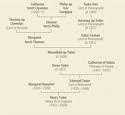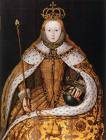
Tudor architecture is actually something people have some amount of familiarity with compared to some of the stuff I will blog about here. Although I am not sure examples of it always date to the period, that familiarity is at least something for me as a HUGE enthusiast of all aspects of the time period to find common ground on. There are some interesting reasons for the fact that Tudor architecture is widely recognizable, which I will touch on. There are also quite a few myths about it (which probably happens any time there is culturally spread information), and I will probably work on this post a while to systematically deal with the myth vs. reality issues that are interesting to hardcore folks in a way that also informs beginners.
As far as illustrations go: I would love to start travelling to take my own photos of some of these buildings, and maybe draw some of my own illustrations. In the meantime I may be a little guilty of 'hijacking bandwidth' or whatever it is called. But I will do it sparingly to be cautious. That is one reason why I don't have as many illustrations of this post as I would like.
There is a certain stereotyped look of Tudor architecture, such as the picture of the house I included in the margin of the blog. My sister-in-law (who grew up in a village around Cambridge I think) said it looked like some of the typical houses near there. And tell the truth I don't know whether that house is 'original' to the Tudor period or not. It could be, it definitely has some of the features. One of the things about it that makes me think possibly yes is the reverse-pyramid style. During the Tudor era it was the very beginning of urbanization where workers moved to cities for employment rather than working land, and thus they flooded the infrastructure of towns before they could accommodate it easily. This made the building real estate on the street level very valuable, and as things went upward they could afford to get wider, even though this probably was extra tricky to do structurally.
But this building may be newer because it turns out that very few of the buildings that give Tudor architecture its reputation are original, they are more likely to come from Tudor 'revival' periods, especially ones like this that look especially typical, lots of posts and exaggerated patterns, etc. There are big waves of Tudor revivalism, one close after it in the seventeenth century, a big one in the 1920's-30's, and there is even a lot of it in our day. Donna and Jim's house has some of it. But most of the real houses that people lived in at that time are much less distinctive looking or even interesting looking at all. The kind of look like very simple houses, like the drawn image above.
The fact is that most buildings that were 'nice enough' to end up surviving to our day from the sixteenth century are actually brick, not the 'black and white' post and mortar composition that creates the look. Cardinal Wolsey, for example, built Hampton Court Palace in conspicuous red brick because that was the real prestige, cutting-edge look. This stylishness, rather than its actual 'palatial' fanciness, was one of the reasons that made this particular house so coveted and thus swiped by Henry VIII.
I realized that 'Tudor' style is probably one of the oldest styles of domestic architecture of any kind, meaning types of houses or any secular structures versus types of churches such as Gothic, Byzantine, Romanesque, or whatever, and I wondered whether there was a reason for this. Turns out, yes. The Tudor period represents probably the first time in European history where because of typical reformation efforts (like Henry's dissolution of the monasteries) there were actually a good percentage of important structures that served a mainly secular purpose.
This naturally bled over into residential architecture (I am assuming this so no one quote me for a term paper) because before this period, anyone who drew plans for a living would probably need to concentrate on various religious structures, from big ones like Cathedrals to smaller village churches. After decentralization of worship, there was more of a need for architects to do other things. Also, because the late medieval ages (or the Tudor period) was also the beginning of the modern era, or thus the very start of a kind of suburbia or middle class.
Because of the plague and other factors that grew the middle class, more and more people were able to do something other than live in shacks or hovels. So they would have their homes actually constructed based on some kind of professional plans rather than what ever they could raise in a weekend. So Tudor houses are actually some of the earliest houses constructed according to any real architectural style rather than just a result of whatever building materials and technology existed, because probably before these houses nothing much existed of any preservable quality.
So this kind of explains why Tudor architecture is even a kind of architecture at all--at least why it is one of the earliest famous kinds of domestic structures. Because there was more and more mass production for the middle class, more and more smallish houses were made with an eye toward design. So while before this, say in the period of Norman castles, either you had the money to throw up a house the size of a town or you had a one room shack, there were people who had a little bit but that little bit was worth fancying up. So there was more reason to do things like concentrate on doors, chimneys, arches, etc. which all have distinctive equivalents in this period. Tudor leaded glass windows are a good example of the new focus on craftsmanship on a more modest scale accessible to the masses.
One of the interesting phenomena of Tudor houses was actually an example of the increasing fashionableness of deliberately 'antiquing' houses and design. I find it fascinating that the famous thatched roofs of Stratford upon Avon seem to never exactly exist originally. There are reputed reasons that people may have engaged in this building practice on purpose, but by Shakespeare's day, most of the thatched roofs are really an attempt to look 'old fashioned'!
Several of these interesting features are pulled from various sites because I wasn't able to find all of the things I found informative about this architecture in one place, but one of the sites (from which I pulled an image) is a good one and I can't find it now or I would attribute it.
[Under construction: explanation of post and mortar look. I was actually surprised that no one had put the history of this technology with these other facts I mention already. At first, anyway; I guess I do run into that fairly often]
Back to the crazy wiggly post house on the main page to the left; it at least has the look of a house that is particularly 'representative' of a period and thus recognizable are actually from the end of that period. This is when a look needs to become exaggerated enough to actually stand out as itself. What I mean here is that for something to look distinctive it is actually getting to the point that it is overdone.
Consider hairstyles for example. I try very hard to not look like I have a de-la-mode hairstyle, because the very hairstyles that are 'in' are the ones that will eventually look 'dated.' Right now those flippy-outy hairstyles are very cool, but what will be tomorrow's dated look are today's blend in as hip. Facial and body piercing is kind of the same way. Initially it was probably a nose ring or a lip ring or whatever, but to actually sustain the 'cool' look of a stud, it has gotten to the point where people are volunteering as human pin cushions.
So Tudor architecture today is probably an abstraction and concentration of a few features that did have historical origin to the period, but were probably not actually very representative of much that really existed.











No comments:
Post a Comment